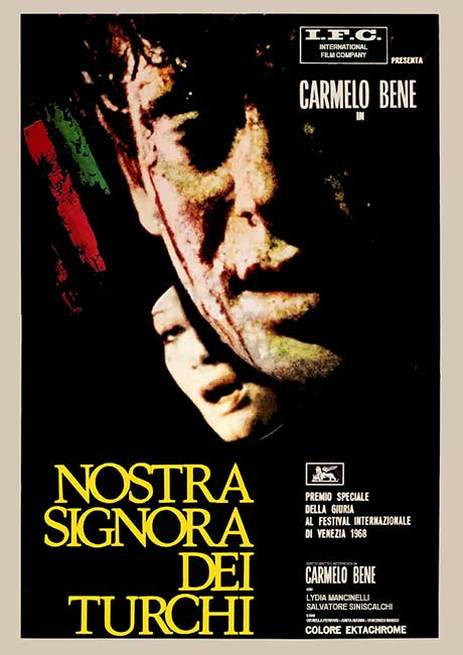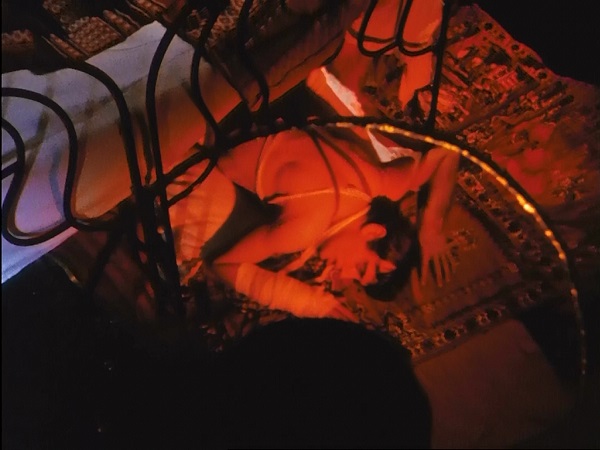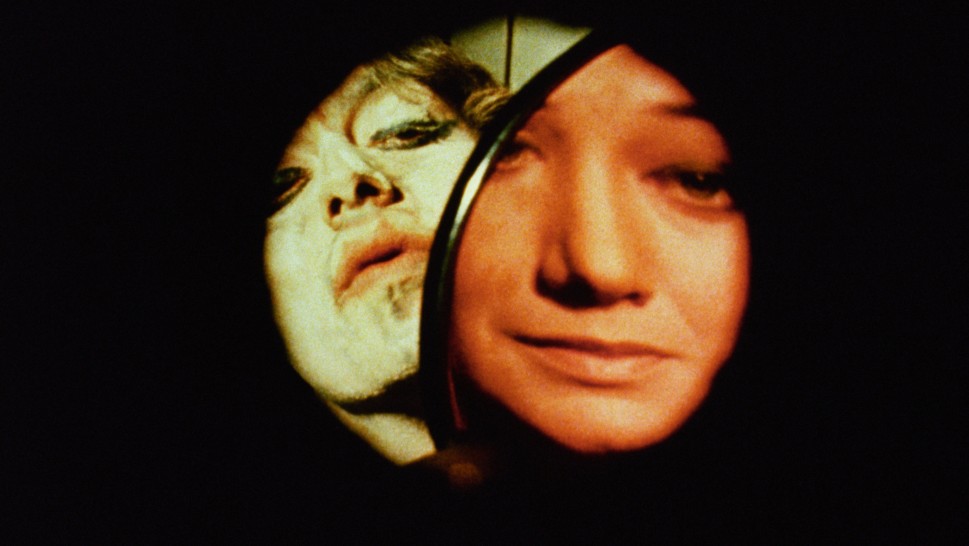Director: Carmelo Bene
Screenplay: Carmelo Bene
Cast: Carmelo Bene as The Man / Narrator; Lydia
Mancinelli as Saint Margareth; Salvatore Siniscalchi as The Publisher; Anita
Masini as Holy Mary / The Woman
[Plot Details and Spoilers]
 All careers begin somewhere, and
the cinematic debut of Carmelo Bene as
director was here. I had thought to my surprise, in lieu to his future
trademark of hyper-exaggerated acting and artificially rich environments, of
how subdued the prologue is. This will change, but Our Lady of the Turks for a large portion of its length is a calmer
production, beginning with the narrator (Bene
himself) elaborating the tale of the Martyrs of Otranto, inhabitants of the
Salentine city of Otranto in southern Italy who were killed on 14th August 1480
by an invading Ottoman force who took the city, described here as being
massacred as they refused to convert from their Christianity to Islam. From
here, Bene builds to a delirium very
common to his other work but with a different tact.
All careers begin somewhere, and
the cinematic debut of Carmelo Bene as
director was here. I had thought to my surprise, in lieu to his future
trademark of hyper-exaggerated acting and artificially rich environments, of
how subdued the prologue is. This will change, but Our Lady of the Turks for a large portion of its length is a calmer
production, beginning with the narrator (Bene
himself) elaborating the tale of the Martyrs of Otranto, inhabitants of the
Salentine city of Otranto in southern Italy who were killed on 14th August 1480
by an invading Ottoman force who took the city, described here as being
massacred as they refused to convert from their Christianity to Islam. From
here, Bene builds to a delirium very
common to his other work but with a different tact.
In this context provided by his
voice over, Bene plays a nameless
man, a personification of a figure whose bones are part of their surviving
form, the Cathedral of Otranto having the bones of the martyrs built into an
alter of skulls in their memory, Bene
a man who prayed to the Madonna during the Ottoman force's attack. In this form
however, said man is now a figure who wanders both the landscape and between
time, in the modern day region of Apulia, Italy and in the past including as a
knight. Bene has used real locations
later, but it is a jolt to see him use far more naturally decorated locations,
including the startling sight of the Alter of Otranto housing those skulls, and
environments whose natural lightning and form are a vast contrast to the
sensitory overloading stages of films into the seventies like Salome (1972).
The pace is also more subdued for
a long time, taking its time to escalate as, in the midst of his aimlessness,
the Man has rejected his initial faith and is even trying to flee the Madonna
he once beckoned to, something which is proven difficult for him as he manages
to court the influence of the of the female saint Santa Margherita (Lydia Mancinelli), who is there under
the presumption that under her (wire) wings and halo he can become a noble
figure. Plot wise, it is a film of tangents, including a period of trying to
publish the writings he made of her to a publisher and being stricken by an
illness which proves a hindrance to Margherita's desire (and romantic interest)
in this lowly mortal and his holiness. Eventually, finding a way with her
influence to effectively get his leg over with a woman, proves the breaking
point for her in this relationship.
It is a difficult film eventually
to grasp, at least within one viewing, as it shudders into tangents and
extremes. Our Lady of the Turks even
passes into territory with Bene
playing Carmelo Bene, at least
evoking the real man as audio of an interview is eventually heard about his
relationship with cinema and desire to break from Italian neo-realists like Roberto Rossellini. Reality is disrupted
anywhere between his sleep being intruded upon when his bed is unexpectedly
near pedestrians and a passing car, or when (using a very grotty stove) he
looks like he is injecting heroin (or something) into a buttock in the middle
of the outdoor area at a cafe. He even hunts down and shoots himself in one of
the first scenes of the film after the prologue, imagery which can be
interpreted many ways but could be seen the fragments of this figure, clearly a
soul lost in purgatory as his remains are in the Altar of Otranto, stuck in the
scenario of not wanting Santa Margherita to follow him but that, if she leaves,
he will die fully and she will not be allowed by up-above to resurrect him.
If there is any coherent through
line to what any of this means, one monologue does grow in hindsight, where Bene in voiceover talks of how rarely
people see the Madonna, that "idiots" who see the Madonna become her,
a madness which brings them to a saintliness inside themselves, whilst those
"idiots" who do not wander from alter to alter, to people and women,
trying to find her, possible to get to Heaven but (as perfectly used as a
metaphor) like dragging oneself to the gates with one's feet amputated, the
onlookers looking on at the blood trail behind oneself and realising that will
eventually prevent a person from getting there. Religious faith is, truthfully,
a subjective thing and, if one believes in Gods, a very unpredictable thing
which does not come to one's disposal at a beck and call at a moment's notice,
not even needing to be more than a subtle change of mood anyway and not
requiring a burning bush unless to get the message across in very significant
situations.
In his character's rejection of
Catholicism and his roots, and knowing the director-writer-star is Italian, a
Roman Catholic country, I cannot help but see the one clear plot thread in this
having a greater weight, the utter difficulty of raising oneself to a holistic
good or a holistic virtue an issue, even if he was not rejecting it, found in
how the Man succumbs to temptations and dicking about to a Saint's
frustrations. Ironically, at the moment when he rejects her, the Man finds the
Madonna, and she is not a vague figure constructed from puritanical
objectification either. She is not perfect, hinting that she was not a perfect
person even in Heaven but getting sainthood still means she at least earned it,
a sympathetic and beautiful figure with her homemade (theatrical stage) prop
halo and wings who is disappointed that her knight figure. Whilst it might have
been a blasphemous scene on purpose, the moment she first appears it is very
much implied Santa Margherita sleeps with him, the next morning undressed in
his bed baring her halo reading a fashion magazine and smoking. It also offers
something sweet in itself, a Saint who is still human, still has desires and is
depressed when he is eyeing another woman instead, but still earned the halo.
It is to the point she has
decided to tow along with this shambolic "jerk", even taking a boat
and rowing it for him as they travel over the sea, only to have the Man find an
excuse to merely shag a woman, a homely earthy figure with infant who is just
an innocent bystander in his madness and not villainized either. In fact, the
earthy description is more than apt, she is literally shot bare breasted as a
figure of Mother Nature at one point in a disorientation close up from inside
the soil upwards, a figure of beauty too. Literally, at one point he is the
knight, his soul trapped in the bones preserved as decorations in the Altar of Otranto,
just wanting that same woman to release him, to bury his bones, but that is
just a ploy to seduce her.
The sequence that shows the
breaking point for this character of the Man, and how far he has gone, capable
of some humanity but also lost permanently, is also evidence of how good Carmelo Bene in terms of his performance
and sustaining such a hyper intense acting style, when he eventually becomes
two people briefly, an older monk and a younger one, not depicted in
duplication technique but Bene acting
out both by himself, occasionally with a fake beard to differentiate the two.
Acting like this is not giving as much deserved respect as it should be, as to even
perform at this level of intensity regardless of the type of film would be
difficult and a strain physically. It is a frenzy onscreen here, this character
reduced to a gibbering idiot, between a cruel and older figure who lashes out
at the other and that younger monk who squeals in pain between the pair trying
to eat. By this point, the aesthetic from its naturalistic locations has
aspects that are utterly grotesque and grim, the least sanitary cooking stove
in any film at least witnessed here, whilst Bene
shows both an incredible way of cracking an egg on his own head, without
looking the yolk, only to start eating it raw when his monk character is meant
to be making an omelette. It is a cacophonous sequence, played by only one man
who sparks with a thunderous, scary energy.
The production has a heavier
reliance on real life locations - in the middle of the day in idyllic locations
no less too - which changes Our Lady of the Turks from Carmelo Bene's later films. Those later productions had a
tremendous visual palette but an artificial one, the aforementioned Salome even predating eighties
underground films like Dr. Caligari
(1989) for neon colours, or One
Hamlet Less (1973) being a work of elaborate costume and visual work. The
greater emphasis here on naturalistic and ornate set design is a striking
change, especially as Bene eventually
shifts the tone to a far more grimier and gothic tone, even himself
transforming at one point in a revenant like figure with eyes rolled back into
the head and affecting a cavernous voice. It lives up to his intensity still,
and you will eventually find one lost in the delirium, but the change in
aesthetic allows this film to have uniqueness among his filmography.
Out of all of them, Bene's debut was successful in terms of
that, at the 1968 Venice Film Festival, Our
Lady of the Turks won the Special Jury Prize, sharing it with the Robert Lapoujade film Le Socrate (1968). The Special Jury
Prize is just below the main Golden Lion that was won by another director not
easily available as he probably should be, West German figure Alexander Kluge for a collage structured
film about circus performers Artists
Under the Big Top: Perplexed (1968), which I openly confess to have never
have heard of before researching this. Considering the competition had Pier Paolo Pasolini's Teorema (1968), who Bene would be cast in his 1967
adaptation of Oedipus Rex, and John Cassavetes' Faces (1968), that was a pretty big success for Bene to have accomplished1.
It's worth mentioned Amos Vogel's Film as Subversive Art (1974),
as if anything is partially responsible for these reviews, that and all the
podcasts and tomes championing cult cinema made an impact for myself in
combination with Vogel's championing
of subversive and unique productions. Seeing the image of Bene in the book, as that almost undead figure with the pupil-less
eyes, I did not realised that, in a bizarre future, I would be watching this
unique film on Amazon Prime streaming, but the aura around this film has
thankfully become even stronger as a result of actually seeing this. It lives
up to that initial discovery, the text review of the book I found in the
university library, and a reminder of this very different era of cinema of the
sixties and seventies that Carmelo Bene
existed in. He could be able to create an almost improvised, stream-of-consciousness
like tale like this with this level of theatricality. It is apt to talk of his
career from the first film as, by the late seventies to the end of his life, he
would be mostly filming TV movies and documentaries after a fever dream of
films to 19732. He started here perfectly, with Our Lady of the Turks, and Bene
would not disappoint after his initial success either.
Abstract Spectrum: Avant-Garde/Delirious/Intense/Surreal
Abstract Rating (High/Medium/Low/None): Medium
===
1) Whilst IMDB is not always
reliable, their source as of 10th May 2020 [HERE] also had Maurice Pialat's first theatrical film L'Enfance Nue (1968), D.A. Pennebaker's concert film Monterey Pop (1968), and films by Miklós Jancsó and Juraj Jakubisko among those screening. Time has made other films
more acclaimed since the decades have passed, but it's fascinating in itself to
see such idiosyncratic productions jostled together like this, causing one to
wonder how in the future Cannes and Venice Film Festival premieres of the 2000s
and 2010s will be seen.
2) All, having yet to see Capricci (1970), deserving a box set
that both art house and cult cinema fans would by enraptured by.



No comments:
Post a Comment